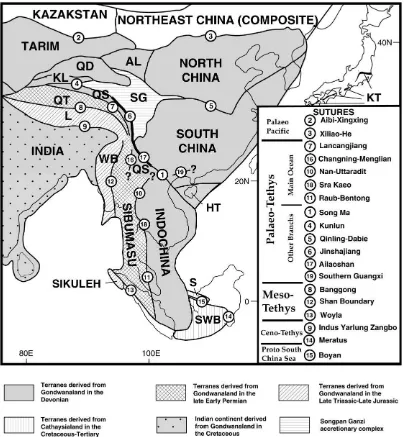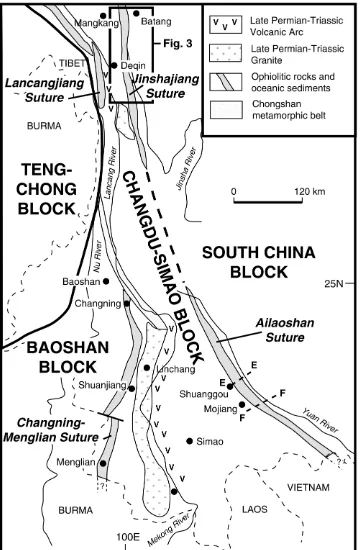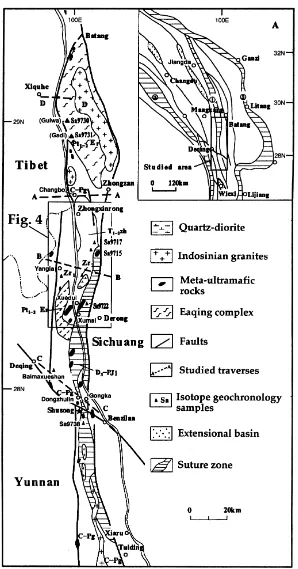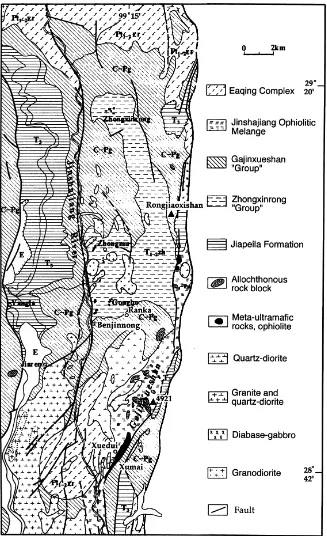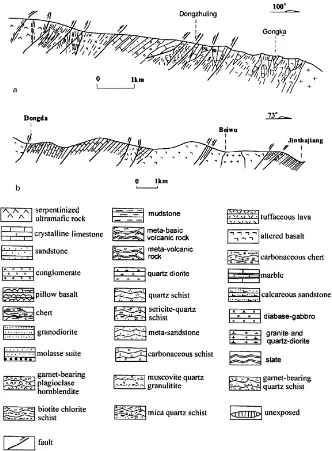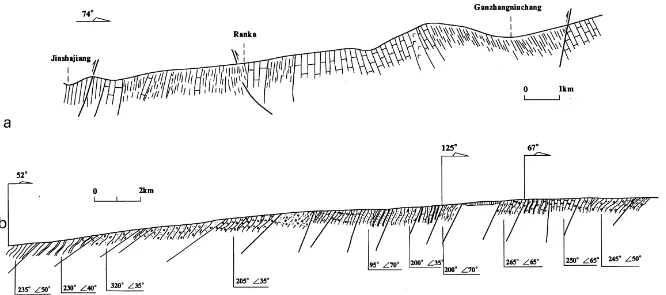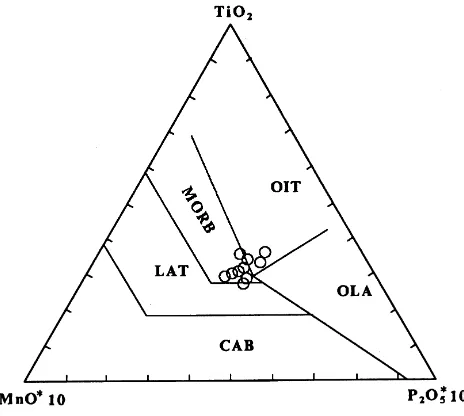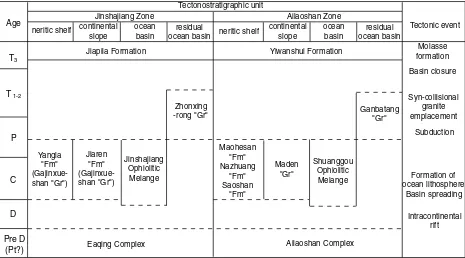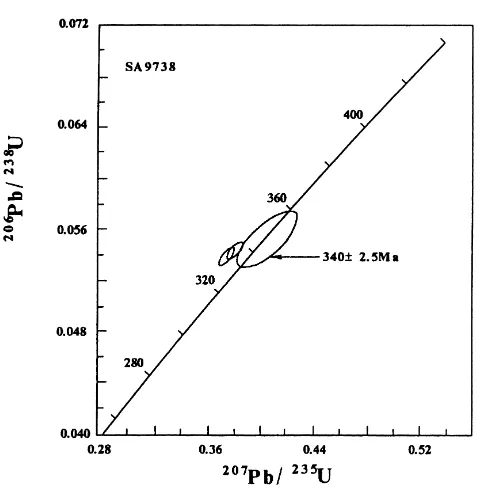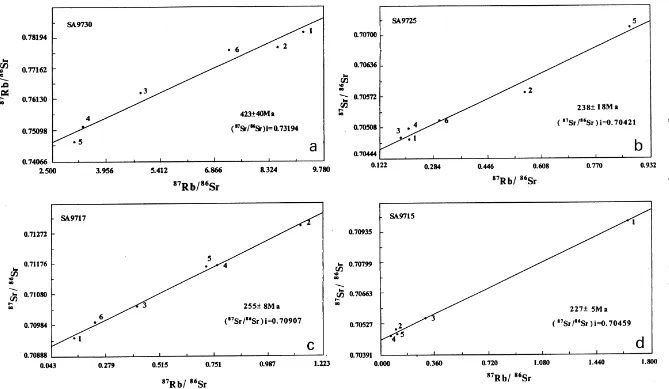The Jinshajiang–Ailaoshan Suture Zone, China: tectonostratigraphy,
age and evolution
Xiaofeng Wang
a, I. Metcalfe
b,*, Ping Jian
a, Longqing He
a, Chuanshan Wang
aa
Yichang Institute of Geology and Mineral Resources, CAGS, Yichong, People’s Republic of China
b
Asia Centre, University of New England, Armidale, Australia
Received 12 March 2000; accepted 20 July 2000
Abstract
The Jinshajiang Suture Zone is important for enhancing our understanding of the evolution of the Paleo-Tethys and its age, tectonic setting and relationship to the Ailaoshan Suture Zone have long been controversial. Based on integrated tectonic, biostratigraphic, chemostrati-graphic and isotope geochronological studies, four tectono-stratichemostrati-graphic units can be recognized in the Jinshajiang Suture Zone: the Eaqing Complex, the Jinshajiang Ophiolitic Melange, the Gajinxueshan “Group” and the Zhongxinrong “Group”. Isotope geochronology indicates that the redefined Eaqing Complex, composed of high-grade-metamorphic rocks, might represent the metamorphic basement of the Jinsha-jiang area or a remnant micro-continental fragment. Eaqing Complex protolith rocks are pre-Devonian and probably of Early–Middle
Proterozoic age and are correlated with those of the Ailaoshan Complex. Two zircon U–Pb ages of 340^3 and 294^3 Ma;separately
dated from the Shusong and Xuitui plagiogranites within the ophiolitic assemblage, indicate that the Jinshajiang oceanic lithosphere formed in latest Devonian to earliest Carboniferous times. The oceanic lithosphere was formed in association with the opening and spreading of the Jinshajiang oceanic basin, and was contiguous and equivalent to the Ailaoshan oceanic lithosphere preserved in the Shuanggou Ophiolitic Melange in the Ailaoshan Suture Zone; the latter yielded a U–Pb age of 362^41 Ma from plagiogranite. The re-defined Gajinxueshan and Zhongxinrong “groups” are dated as Carboniferous to Permian, and latest Permian to Middle Triassic respectively, on the basis of fossils and U–Pb dating of basic volcanic interbeds. The Gajinxueshan “Group” formed in bathyal slope to neritic shelf environments, and the Zhongxinrong “Group” as bathyal to abyssal turbidites in the Jinshajiang–Ailaoshan back-arc basin. Latest Permian–earliest Middle Triassic synorogenic granitoids, with ages of 238^18 and 227^5–255^8 Ma;respectively, and an Upper Triassic overlap molasse sequence,
indicate a Middle Triassic age for the Jinshajiang–Ailaoshan Suture, formed by collision of the Changdu-Simao Block with South China.
q2000 Elsevier Science Ltd. All rights reserved.
Keywords: Jinshajiang; Ailaoshan; Suture zone; Tectonostratigraphy
1. Introduction
Eastern Asia is an amalgamation of allochthonous conti-nental terranes (Fig. 1) which had their origin on the margin of Gondwanaland (Metcalfe, 1988; Metcalfe, 1996a,b, 1998). The remnants of oceanic basins which once sepa-rated these continental terranes are now preserved along narrow suture zones that form the boundaries between the various allochthonous blocks. Detailed studies of the various suture zones of the region provide much valuable information on the history of the ocean basins they represent and on the tectonic history of the continental blocks they bound. This paper presents new information on the Jinsha-jiang and Ailaoshan suture zones in south-western China
(Fig. 2), here interpreted to be contiguous, which necessi-tates a reinterpretation of the tectonic history of this region. Metamorphic rocks are widespread in the Jinshajiang– Ailaoshan Suture Zone and represent several huge mixed or accumulated bodies. They comprise mixed and overlap-ping rock bodies or rock blocks of different age and origin, which underwent several episodes of metamorphism and deformation. These huge mixed bodies stretch along both sides of the ophiolitic melange situated in the central part of the suture zone from north to south (Fig. 3). Traditional stratigraphic principles are not applicable to these dismem-bered metamorphic rocks. The origin, age and tectonic environment of these rocks, and their relationship to Paleo-Tethys evolution, have long been controversial. This paper presents results of our ongoing studies on the basis of three traverses across the Jinshajiang Suture Zone (Ganzhangniuchang-Benjinnong, Zhongza-Changbo and
Journal of Asian Earth Sciences 18 (2000) 675–690
1367-9120/00/$ - see front matterq2000 Elsevier Science Ltd. All rights reserved. PII: S 1 3 6 7 - 9 1 2 0 ( 0 0 ) 0 0 0 3 9 - 0
www.elsevier.nl/locate/jseaes
* Corresponding author. Fax:161-2-67733596.
Deqing-Benzilan) and two traverses across the Ailaoshan Suture Zone (Yakou-Laowangzai and Mojiang-Yuanjiang) as well as biostratigraphical, tectonic, chemostratigraphical and isotope geochronological investigations of other areas including Xumai and Shuanggou.
2. Tectonostratigraphic subdivision
The metamorphic rocks exposed in the Jinshajiang– Ailaoshan Suture Zone represent a mixed assemblage resulting from various plate tectonic processes, polyphase metamorphism and deformation. Each huge mixed body comprises many secondary rock blocks of different size
and origin. For example, the original Gajinxueshan and Zhongxinrong groups, established by the Sichuan Team of Regional Geology (STRG) in 1997, are an associa-tion of several huge mixed rock bodies, widely exposed in the Jinshajiang Suture Zone. In a sense, they might be considered as a set of “strata” formed at different times and in different tectonic settings. Based on studies of the tectonic settings of these rock assemblages, their tectonic boundaries, metamorphism and deformation, it is suggested that four tectono-stratigraphic units be recognized, i.e. the Jinshajiang Ophiolitic Melange, rede-fined Gajinxueshan “Group”, Zhongxinrong “Group” and the Eaqing Complex in the Jinshajiang Suture Zone (Fig. 4).
Fig. 1. Principal continental lithospheric blocks (terranes) and sutures of East and Southeast Asia. WBWest Burma, SWBSouth West Borneo, S
2.1. The Jinshajiang Ophiolitic Melange
The Jiangshajiang Ophiolitic Melange, as a special component of the Jinshajiang Suture Zone, is well-exposed in the Xiaruo-Tuoding, Shusong-Gongka and Xumai-Xuedui areas to the south of Zhongzan (Figs. 3 and 4) and
shows characteristics of a typical variably disrupted ophio-litic suite. It is easily distinguished from the redefined Gajinxueshan “Group” by its different rock assemblages and is usually distributed on both sides of the Gajinxueshan “Group”. In the Jinshajiang Ophiolitic Melange the clasts consist mainly of basic and ultrabasic rocks and limestones, X. Wang et al. / Journal of Asian Earth Sciences 18 (2000) 675–690 677
while the matrix comprises scaly serpentinites, siltstones, pelitic and siliceous rocks (Fig. 5). The Jinshajiang Ophio-litic Melange was formed by subduction–accretion processes. Early Carboniferous radiolarians and conodonts
are reported from chert and siliceous limestone interbeds within pillow basalts in the Xiaruo area, Deqing (Wu, 1993; Feng et al., 1997). The main elements include the radiolarians, Albaillella indensis indensis Won, Entactinia
vugaris vugaris Won, E. parva Won, E. tortispina
(Ormis-ton and Lane) and the conodonts Gnathodus typicus Cooper,
G. girtyi rhodesi Higgins and Spathognathodus sp. Some
Early Permian radiolarians, including Albaillella sp.,
Pseu-doalbaillella sakmarensis (Kozur)?, Follicucullus ventrico-sus (Ormiston and Babcock)? and Follicucullus sp. are
found in purple chert intercalated within pillow basalts at Gongka, Benzila. Two zircon U–Pb ages of 340^3 and
294^3 Ma are separately obtained from the Shusong and Xuitui plagiogranites, respectively, within the ophiolitic assemblages (see below). These two plagiogranite U–Pb ages probably indicate that the Jinshajiang Ophiolitic rocks was formed during the latest Devonian/earliest Carbo-niferous or CarboCarbo-niferous times in association with opening and spreading of the Jiangshajiang ocean basin. The Jinsha-jiang Ophiolitic Melange is interpreted to have formed X. Wang et al. / Journal of Asian Earth Sciences 18 (2000) 675–690 679
mainly in the Carboniferous, but ranging up to Permian on the basis of fossils and isotopic data. The ophiolitic melange of the Ailaoshan Suture Zone was included in the Madeng Lithogroup by the Yunnan Bureau of Geology and Mineral Resources (YBGMR, 1996) (Fig. 3). It is quite similar to the Jinshajiang Ophiolitic Melange in terms of rock assem-blages, and metamorphic and deformation characteristics, and is well exposed in the Shuanggou-Mojiang area. A plagiogranite from the Shuanggou Ophiolitic assemblage yields a U–Pb age of 362^41 Ma (Jian et al., 1998a). These are the first isotopic ages to indicate that the Jinsha-jiang and Ailaoshan ophiolitic melanges are contiguous and equivalent to each other. It is suggested here that the ophio-litic melange of the Ailaoshan Suture Zone should be
sepa-rated from the Madeng Lithogroup and named the Shuanggou Ophiolitic Melange.
2.2. The Gajinxueshan “Group”
The Gajinxueshan “Group”, characterized by turbiditic clastic sediments, is redefined here as including the major part of the original Gajinxueshan Group and the lower part of the former Zhongxinrong Group. It is the most widely distributed tectonostratigraphic unit of the Jinshajiang Suture Zone and is widely exposed on both sides of the Jinshajiang river. Investigations of the three traverses, Dongda-Nilu, Ganzhangniuchang-Benjinlong and Changbo-Zhongza (Figs. 5b, 6a and b) indicate that the original
X.
Wang
et
al.
/
Journal
of
Asian
Earth
Sciences
1
8
(2000)
675
–
690
681
Gajinxueshan Group includes four rock assemblges formed in different tectono-palaeogeographic environments:
1. ophiolitic melange produced by subduction/obduction, i.e the Jinshajiang Ophiolitic Melange;
2. turbiditic greywackes of hemi-deep water on the continen-tal marginal slope or island arc, sometimes together with basic volcanic rocks and allochthonous or sea-mount massive limestone blocks;
3. carbonates with volcanic interbeds on the shallow to deeper shelf;
4. turbidites of the residual Jinshajiang–Ailaoshan back-arc ocean basin, i.e. the redefined Zhongxinrong “Group”.
These rock assemblages with different deformation and metamorphic structures are separated from each other by faults.
The redefined Gajinxueshan “Group” mainly comprises the above assemblage 2., i.e. clastic flysch sediments, and assemblage 3., i.e. carbonates with volcanic interbeds. The former is called the Jiaren “Formation” (Figs. 5a, 6a and b) and the latter the Yangla “Formation” (Fig. 7). The type sections are situated in the Gajinxueshan area (Fig. 6a). The massive limestone blocks exposed in the upper part of the Jiaren “Formation” yield the corals, Wentzelella sp.,
Yuanophyllum sp., Kueichowpora sp., Diphyphyllum sp., Lophophyllum sp., Syringopora sp. and Palaeosmilia sp.
in the Gajinxueshan area and the conodonts,
Delinognatho-dus lateralis (Higgins and Bouckaert), DelinognathoDelinognatho-dus sp.
and Neogondollella sp. and the fusulinids, Pseudofusulina sp. in the Benzinan area (Chengdu Institute of Geology and Mineral Resources, i.e. CIGMR and YBGMR, 1992). Among these fossils the corals represent the Lower
Carbo-niferous, except Wentzelella. which is usually found in the Permian. The conodonts and fusulinids are common Carbo-niferous forms. The Jiaren “Formation” is therefore inter-preted to be of Carboniferous age, but possibly extending into the Permian. It is not yet clear whether the massive limestone represents an allochthonous block or blocks, which should then be referred to the Jinshajiang Ophiolitic Melange, or to an oceanic island or sea mount deposit (He and Chen, 1998).
The Yangla “Formation” comprises carbonate interca-lated with basic volcanics, which are usually distributed on both sides of the Jinshajiang river, together with the redefined Jiaren “Formation”. The type section is located in Yangla, Deqing (Fig. 6a). Basalt collected from the Yangla “Formation” of Yangla area has provided U–Pb ages of 362^9–296^7 Ma;which indicates a Carbonifer-ous age for the Yangla “Formation” (see below).
2.3. The Zhongxinrong “Group”
Recent work has shown that two volcanic rock units, separately included in the original Zhongxinrong and Gajin-xueshan groups, are the same unit, and are equivalent to the Yangla “Formation” of the Gajinxueshan “Group”. This necessitates a redefinition of the Zhongxinrong “Group”. The redefined Zhongxinrong “Group” is characterized by flysch sediments, consisting of low grade metamorphosed sandstone and siltstone and carbonaceous slate with inter-beds of thin-bedded limestone and rare basic volcanic rock. It is in fault contact with volcanics of the Yangla “Forma-tion” in the Zhongmu and Zhongxinrong areas. Study of sedimentary facies indicates that the Zhongxinrong “Group” formed as bathyal–abyssal turbidite deposits in the narrowing Jinshajiang–Ailaoshan ocean basin. No fossils have been found so far, but the isotopic geochrono-logical dating of gabbro and granite, intruded into the Zhongxinrong “Group” of the Zhongmu area, gives Rb–Sr ages of 227^5 and 255^8 Ma;respectively (see below). Hence the Zhongxinrong “Group” would probably have been formed in the latest Permian to early Middle Triassic time and hence be younger than the Gajinxueshan “Group”.
2.4. The Eaqing Complex
The Eaqing Complex, exposed in the Batang-Suwalong area and on both banks of the Jinshajiang River, west of Xumai, is composed of high-grade metamorphic rocks. The metamorphic grade attains epidote–amphibolite facies to amphibolite facies together with common migmatization. The name “Eaqing Complex” is derived from the Eaqing Group (Sichuan Team of Regional Geology, 1980), which was proposed to replace the Gajinxueshan and Zhongxin-rong groups by CIGMR and SBGMR (1992). SBGMR (1997) redefined the Eaqing Group as a formation including four members, and interpreted it to be of Permian age. This stratigraphic subdivision of an amphibolite unit is ques-tioned here. Isotopic geochronological studies indicate
that the metamorphic age of these high-grade metamorphic rocks, exposed in the Suwalong area, are pre-Devonian, and possibly as old as Early–Middle Proterozoic. The redefined Eaqing Complex might represent the metamorphic base-ment (remnant micro-continental fragbase-ment) of the Jinsha-jiang area or high-grade metamorphic accretionary complex rocks.
2.5. Correlation
In the Ailaoshan Suture Zone two sets of metamorphic rocks with characteristic rock assemblages, metamorphism and deformational structure were established by YBGMR (1990, 1996): the Madeng Lithogroup and another, unnamed, lithogroup. The former is characterized by meta-morphic rocks of lower greenschist facies with strong defor-mation. The latter is further subdivided into the Meiziqing, Kudumu, Shuoshan, Nazhuang and Maoheshan lithoforma-tions. We deduce that these two sets of metamorphic rocks were formed in different tectonic/palaeogegraphic positions. Integrated studies on the mixed metamorphic rocks of the Jiangshajiang and Ailaoshan suture zones suggests that the Eaqing Complex is equivalent to the Ailaoshan Complex and that the redefined Jiaren “Formation” equates to the Madeng “Group”, excluding the Shuanggou Ophiolitic Melange. The Yangla “Formation” equates to the Maohe-shan, Nazhuang and Suoshan Lithoformations, and the Zhongxinrong “Group” is similar to the Ganbatang Lithogroup in lithological association. The Jinshajiang and Shuanggou ophiolitic melanges appear to have been formed at the same time and to be contiguous with each other (see
below). A correlation of the tectono-stratigraphy of the Jinshajiang and Ailaoshan suture zones is shown in Table 1.
3. Geochemical implications
A detailed study on the basalts exposed in the Jinshajiang Ophiolitic Melange from the Baimaxueshan, Shusong and Gongka areas was made by Han et al. (1996). The results indicated that the basalt composition falls mainly into the MORB on the TiO2–MnO–P2O5diagram, only a few data
points falling in the oceanic island tholeiite (OIT) field (Fig. 7). This suggests that at least a part of the remnant oceanic crust in the Jinshajiang Suture might be derived from ocea-nic ridge spreading (ORS). On the other hand, element distribution from these basalts also shows a transitional character from MORB to OIB. A similar result is also obtained from basalts of the Ailaoshan Ophiolitic melange.
4. Isotopic geochronology
4.1. Jinshajiang Ophiolitic Melange
Plagiogranite is considered a typical oceanic granitoid, being the product of magmatic differentiation, and is more widely found in the Jinshajiang Ophiolitic Melange. Samples for isotopic study were collected from separated plagiogranites, occurring in the metamorphic peridotites of Shusong, Xuedui and Rongjiaoxishan. Preliminary results are here presented from the Shusong plagiogranite and Xuedui plagiogranite. The former is exposed in a road X. Wang et al. / Journal of Asian Earth Sciences 18 (2000) 675–690 683 Table 1
Tectono-stratigraphic subdivision and correlation of the Jinshajiang–Ailaoshan Suture Zone
Age
Jiapila Formation Yiwanshui Formation
Zhonxing
Eaqing Complex Ailaoshan Complex
cutting between Deqing and Banzilan (Fig. 3). The latter is found in the Xuedui Ophiolitic assemblage. Both plagiogra-nites occur in tectonic contact with metamorphic peridotite, which is a part of the Jinshajiang Ophiolitic belt.
Zircons were extracted from a fresh 15 kg sample of the Shusong plagiogranite (SA 9738). U–Pb dating was performed in the isotopic laboratory of the Tianjin Institute of Geology and Mineral Resources, China. Isotopic analyses were undertaken on a VG 354 Mass Spectrometer. The mixed spike of 205Pb1235U was used. Total blanks were Pb (0.05 ng) and U (0.02 ng). The ages were calculated using the pbdat and isoplot programs (Ludwig, 1987).
All the ages obtained are at the 95% confidence level. Zircons from the Shusong plagiogranite are a very homo-geneous population with short prismatic crystals. Three analyses give 206Pb/238U ages ranging from 339–347 Ma and 207Pb/235U ages of 323–346 Ma. These results show a slight discordance. The weighted mean 206Pb/238U age is 340^2:5 Ma (Fig. 8, Table 2). This age probably
repre-sents the emplacement age of the Shusong plagiogranite, indicating that the Jinshajiang Ocean was already actively spreading during the latest Devonian to earliest Carboniferous.
Zircons extracted from the Xuedui plagiogranite (SA 9722) are elongated and prismatic in appearance. Three analyses give 206Pb/238U ages ranging from 289–296 Ma and 207Pb/235U ages from 289–294 Ma (Table 2). The analyses show basic concordance. The 294^4 Ma average age of 206Pb/238U would represent the formation age of the Xuedui plagiogranite, indicating that the Jinshajiang ocea-nic spreading occurred in the Carboniferous.
4.2. Gajinxueshan Group
So far, no isotopic ages nor any fossils have been obtained from the clastic flysch deposits in the redefined Jiaren “Formation”, which equates to most of the Gajinxue-shan “ Group”. Some new isotopic results, however, were obtained from the redefined Yangla “Formation”, which includes the original Yangla and Linong lithoformations (Zhan et al., 2000). Two zircon-bearing samples (Zr 1 and Zr 2) were collected from the bedded metamorphic basalt in the Linong mining area. A sample of 60 kg provided only 30–50 zircons with rounded shapes, probably caused by strong solution. Three analysis give 206Pb/238U ages of 523–1354 Ma and 207Pb/238U ages of 757–1786 Ma, show-ing obvious discordance. These zircons have obvious magmatic corrosion, and it is suggested that they were derived from the basement rocks, and are probably crustal relics, caught up in the basalt magma. In association with other inherited zircons of 911^31 and 2119^78 Ma (Jian et al, 1998b), this data further supports the possibility of a Proterozoic metamorphic basement existing in the Jinsha-jiang Suture Zone.
4.3. Eaqing Complex
A fresh sample (SA 9730) sillimanite-bearing two mica schist was collected from a 20 m exposure at Gangda, Batang, West Sichuan (Fig. 3). Rb–Sr analysis was under-taken in the Isotopic laboratory of Yichang Institute of Geology and Mineral Resources (YIGMR). Six analyses
Fig. 8. U–Pb concordia diagram of zircons from the Shusong plagiogranite.
Table 2
U–Pb analyses of zircons from the Jinshajiang plagiogranites
Sample no. Atomic ratios Age (Ma) (2sMa)
206Pb/204Pba 206Pb/238U 207Pb/235U 207Pb/206U 206Pb/238U 207Pb/236Pb 207Pb/206Pb
SA 9738-1 1723 0.5437^0.00059 0.3923^0.0051 0.5232^0.00035 341.3 336 299.6
SA 9738-2 1225 0.05384^0.00064 0.3873^0.0059 0.05217^0.00045 338.1 322.4 292.8
SA 9738-3 1339 0.05366^0.00083 0.3885^0.0085 0.05329^0.00169 346.8 346.1 307.7
SA 9738-4 0.05527^0.00183 0.4061^0.0322 0.5033^0.0035 346.8 346.1 341.2
SA 9722-1 183 0.04702^0.00294 0.3263^0.0322 0.05033^0.0035 296.2 286.7 210.1
SA 9722-2 395 0.04580^0.00169 0.3226^0.0179 0.05109^0.00193 288.7 283.9 244.8
SA 9722-3 1004 0.04665^0.00062 0.3355^0.0058 0.05216^0.00055 294 293.8 292.3
a
X.
Wang
et
al.
/
Journal
of
Asian
Earth
Sciences
1
8
(2000)
675
–
690
685
give a slightly scattered isochron. The Rb–Sr age is 423^ 40 Ma (Fig. 9a, Table 3). This age is interpreted as the age of the high-grade metamorphic event which produced the metamorphic minerals mica, sillimanite, kyanite, etc. The dispersed data points are likely related to modifications that did not affect all minerals in the primary rocks. The Eaqing Complex is derived from the Eaqing Group, which is corre-lated with the original Gajinxueshan Group by CIGMR and SBGMR (1991) and was interpreted as Permian in age by the SBGMR (1997).
However, a new study of the Eaqing Complex shows that
its rock assemblage and metamorphic grade are similar to that of the Ailaoshan Complex exposed in the Ailaoshan area. The metamorphic age of the Eaqing Complex, more-over, is dated at 423^40 Ma:Its protolith age should be therefore older than the Devonian. A zircon sample (SA 9731) from the Gadi plagioclase–amphibolite (Figs. 3 and 4) is dated by the U–Pb method, and shows a more compli-cated pattern (Table 4). It gives an upper intercept age of 1627^192 Ma;providing a minimum age for the volcanic protolith. This indicates the presence of a Meso- to Neo-Proterozoic remnant metamorphic basement, or micro-continental fragment, in the Jinshajiang area, with an age older than 1627^192 Ma: If the time of opening of the Jinshajiang Ocean corresponds to that of the Ailaoshan Ocean, the Eaqing Complex is likely to be equivalent to the Ailaoshan Complex. An analogous high-grade metamorphic series to the Eaqing Complex, exposed in the Batang area, is also found in both sides of the Jinshajiang River in the Xumei area, Deqing. Based on the rock assem-blage and high metamorphic grade, this series in Xumei should be referred to the Eaqing Complex.
Table 5
Rr-Sr data of granite and gabbro from Jinshajiang Suture Zone
Sample no. Rock W(Sr)/26
10 W(Sr)/26
10 87Rb/86Sr 87Sr/86Sr
SA 9717-1 Granite 21.9 446.3 0.1415 0.70948^0.00002
SA 9717-2 Granite 124.7 320 1.125 0.71307^0.00003
SA 9717-3 Granite 55.24 388.8 0.4098 0.71051^0.00003
SA 9717-4 Granite 90.86 351.1 0.7464 0.71178^0.00004
SA 9717-5 Granite 97.06 353.9 0.7095 0.71176^0.00001
SA 9717-6 Granite 34.77 437 0.2294 0.70998^0.00002
SA 9725-1 Foliated granite 34.92 474.9 0.212 0.70484^0.00015
SA 9725-2 Foliated granite 85.49 447.4 0.5508 0.70585^0.00010
SA 9725-3 Foliated granite 29.75 453.9 0.1889 0.70487^0.00001
SA 9717-4 Foliated granite 0.86 557.7 0.2112 0.70507^0.00004
SA 9717-5 Foliated granite 79.33 265.6 0.8612 0.70724^0.00006
SA 9717-6 Foliated granite 49.23 473.6 0.2996 0.70524^0.00004
SA 9715-1 Gabbro 28.83 50.56 1.644 0.70990^0.0006
SA 9715-2 Gabbro 7.672 202.1 0.1094 0.70508^0.00004
SA 9715-3 Gabbro 23.05 219.9 0.3021 0.70558^0.00014
SA 9715-4 Gabbro 4.217 165.4 0.07346 0.70477^0.00005
SA 9715-5 Gabbro 3.174 82.18 0.1113 0.70485^0.0025
Table 3
Rb–Sr data for the kyanite-bearing schist from Suwalong area Sample no. W(Rb)/2610 W(Sr)/2610 87Rb/86Sr 87Sr/86Sr
SA 9730-1 183.3 58.03 9.171 0.78780^0.00007
SA 9730-2 203.1 69.55 8.48 0.78054^0.00003
SA 9730-3 180.6 108.5 4.824 0.76414^0.00003
SA 9730-4 120.9 105.9 3.305 0.75213^0.00029
SA 9730-5 137.1 127.7 7.196 0.77780^0.00065
Table 4
U–Pb data of zircon from Gadi plagioclase–amphibolite
Sample no. Atomic ratio Age (Ma)
206
Pb/204Pba 206Pb/238U 207Pb/235U 206Pb/238U 207Pb/235U
SA 9731-1 1658 0.09298^0.00084 1.052^0.011 573.1 729.1
SA 9731-2 1138 0.08477^0.00139 0.9260^0.0181 524.5 565.5
SA 9731-3 1162 0.04733^0.00106 0.2568^0.0106 250.8 232.1
SA 9731-4 781 0.03628^0.00126 0.2389^0.0129 229.8 215
SA 9731-5 1260 0.1034^0.0024 1.294^0.035 634.5 543.1
SA 9731-6 766 0.0963^0.00172 0.9640^0.0208 592.7 585.4
a
4.4. Geochronology of granites
4.4.1. The Xumai foliated granite (SA 9725)
Samples were collected from foliated granites, intrud-ing the Eaqintrud-ing Complex, about 1 km to the east of Xumai village (Figs. 3 and 4). The metamorphic complex there attains epidote amphibolite facies to amphibolite facies and underwent several episodes of
migmatization. The intrusive relationship between the Xumai granite and its country rocks can be seen in the field. The foliation of the granite is concordant with that of the metamorphic complex. Six whole rock analyses define an isochron age of 238^18 Ma: The age prob-ably reflects the time of a collisional orogenic event. The (87Sr/86Sr) initial value is 0:70421^0:00012; which is significantly lower than the average value of the crust, X. Wang et al. / Journal of Asian Earth Sciences 18 (2000) 675–690 687
implying that the granite probably originated from the mantle (Fig. 9b, Table 5).
4.4.2. The Zhongmu granite (SA 9717)
The Zhongmu granite, intrudes the flysch formation of the Zhongxinrong “Group ” as a stock. The sample was collected in the river bank of the Jinshajiang near Zhongmu village (Figs. 3 and 4). The isochron age defined by six whole rock analyses is 255^8 Ma;with (
87
Sr/86Sr) initial value of 0:709079^0:00008 (Fig. 9c, Table 5). The higher (87Sr/86Sr) initial value indicates that the studied granite was related to crustal melting.
The Rb–Sr ages of the Jiaren and Linong granites, indi-cate that they separately intruded into the redefined Jiaren and Yangla “formations”. These Rb–Sr ages are 208^6 and 227^2 Ma with (87Sr/86Sr) initial values of 0.71027– 0.70640, respectively, (Zhan et al., 2000). These data show that these granites, occuring along the Jinshajiang Suture, formed during Late Triassic to earliest Jurassic times, and that the Jinshajiang ocean was already closed at this time.
4.4.3. Geochronology of high-level gabbro (SA 9715)
Diabase and gabbro are widespread in the Zhongmu area and are in tectonic contact with the Zhongxinrong “Group”. However no associated ultramafic rocks (metamorphic peri-dotite, etc.) and pillow basalt are found in this area. These rocks, therefore, appear not to be part of the ophiolitic assemblage. At present limited petrological evidence is available to determine the petrogenesis of these rocks. Gabbro samples were collected on the eastern bank of the Jinshajiang near Zhongmu village. The isochron age of five whole rock Rb–Sr analyses is 227^5 Ma;with (
87Sr/86Sr)
initial value of 0:70459^0:00006 (Fig. 9c, Table 5), further indicating that the Jinshajiang ocean closed during the Indosinian orogenic episode.
5. Tectonic evolution of Jinshajiang–Ailaoshan Suture Zone
The Jinshajiang–Ailaoshan Suture, palaeogeographi-cally, is situated in the eastern part of the Paleo-Tethys Ocean. From the above discussion, we suggest that the Jinshajiang and Ailaoshan suture zones are contiguous and represent the same ocean basin. This has important implica-tions for a greater understanding of the origin and evolution of the Paleo-Tethys. This conclusion is based on: (a) the two suture zones having comparable lithological assemblages, tectonic deformation, similar metamorphic history and ages; (b) the Ophiolitic Melange of the two suture zones being consistent in their tectonic setting, and ages, further supported by new geochemical and isotopic geochronologi-cal data; and (c) the discovery of several Palaeozoic–Meso-zoic synorogenic granites, such as the Xumai and Zhongmu granites, and a Late Triassic molasse overlap sequence, unconformably overlying the metamorphic rocks of both
suture zones, further indicate identical suturing ages. Comparison of the basement compositions, pre-Devonian sedimentary features as well as the Palaeozoic palaeobio-geographic faunal and floral affinites of the Changdu-Simao and South China blocks (Fig. 1) suggests that the Changdu-Simao micro-continental block probably rifted from the South China Block by back-arc extension and subsequent ocean floor spreading. In this case, the Changdu-Simao Block must be regarded as a separate continental terrane, as previously suggested by Wu et al. (1995), and not an integral part of the Indochina Terrane, as previously suggested by Metcalfe (1996a, 1998). The general lack of open ocean sediments (e.g. ribbon-bedded cherts) presently supports this view. Further work is required in Burma and Northern Thailand to delineate the southern termination of the Changdu-Simao Terrane and elucidate its tectonic rela-tionships with the Sibumasu Terrane. The evolution of the Jinshajiang–Ailaoshan Suture Zone is here interpreted to have occurred in four evolutionary stages as discussed below (Fig. 10).
5.1. Intracontinental rift stage
The Palaeo-Tethys Ocean basin opened when North China, South China, Indochina and Tarim rifted and sepa-rated from the northern margin of Gondwanaland in the Devonian. The main branch of Palaeo-Tethys is represented by the Lancangjiang and Changning–Menglian sutures in SW China, by the Nan–Uttaradit–Sra Kaeo Suture in Thai-land and the Bentong–Raub Suture in Peninsular Malaysia (Metcalfe, 1996a,b, 1998; Metcalfe and Spiller, 1999). Following initial sea-floor spreading of the Lancangjiang and Changning–Menglian segments of the Palaeo-Tethys in the Early Devonian, deposition of Middle–Late Devonian oceanic ribbon-bedded cherts (Liu et al., 1991, 1993) occurred in the ocean, and subduction of the Palaeo-Tethys beneath South China and Indochina in the Middle–Late Devonian to earliest Carboniferous led to back-arc exten-sion and rifting of the Changdu-Simao Massif from South China. The initial Jinshajiang–Ailaoshan back-arc intracon-tinental basin contains graptolite-bearing deep water clas-tics deposited in this basin along the western margin of the South China Block from Luchun-Mojiang to Batang.
5.2. Opening and spreading stage
medial part of the Jinshajiang–Ailaoshan basin. The flysch and turbidite deposits of bathyal facies and carbonate depos-its of neritic facies, intercalated with volcanic rocks (Jiaren and Yangla “formations”), were developed on both passive continental margins of the new oceanic back-arc basin. Massive limestones of limited extent, with Early Carboni-ferous corals, are interpreted as sea-mount deposits. A number of volcanic rocks occurring in the carbonate suite of the Yangla “Formation” are likely related to the subduc-tion of the Lancangjiang Paleo-Tethys Ocean toward the Changdu-Simao Massif.
5.3. Subduction stage
From about the Early–Late Permian boundary the Jinshajiang–Ailaoshan back-arc basin ceased spreading and began its subduction stage. Subsequently, the eastern margin of the Changdu-Simao Massif was changed from a passive continental margin to an active one. This change from spreading to subduction is indicated by four lines of evidence: (a) the occurrence of the Late Permian–early Middle Triassic Zhongxinrong “Group” flysch formed in the narrowing residual Jinshajiang–Ailaoshan basin; (b) the increase of latest Permian to Early Triassic basic volca-nic deposits, unconformably overlying the Yangla “Forma-tion”, in the Jinshajiang Suture Zone; (c) the development of the Jiangda (Jomda)-Weixi volcanic arc in the Middle Permian–Late Triassic on the eastern margin of the Changdu-Simao Block by westwards subduction of the Jinshajiang–Ailaoshan (Mo et al., 1993); and (d) the exis-tence of Late Permian radiolarian cherts (Sun et al., 1997) and passive continental marginal deposits, belonging to the ophiolitic melange in the eastern slope of the Jinshajiang– Ailaoshan oceanic basin. These data additionally indicate that the Jinshajiang–Ailaoshan oceanic basin could not have closed before the Middle Triassic.
5.4. Collision stage
The closure of the Jinshajiang–Ailaoshan back-arc basin is considered an important event in the evolution of not only the Jinshajiang–Ailaoshan Suture Zone, but also Palaeo-Tethys in general. In the Jinshajiang–Ailaoshan Suture Zone the collision, occurring along with the closure of the oceanic basin, led to structural deformation, regional meta-morphism of varying degrees, disruption of the Jinshajiang and Shuanggou ophiolitic melanges, the flysch suites of the Gajinxueshan and Madeng “groups” and the turbidites of bathysal-abyssal facies of the Zhongxinrong and Ganbatang “groups”, formed in the different tectono-palaeogeographic settings of the Jinshajiang–Ailaoshan back-arc basin during the Early Carboniferous to early Middle Triassic. Latest Permian–Middle Triassic synorogenic granitoids, such as the Xumai 238^18 Ma and Zhongmu 255^8–227^ 2 Magranites are distributed along the orogenic belt. The Late Triassic molasse overlap sequences of the Jiapila and Yiwanshui formations, unconformably overlie the
meta-morphic rocks in the Jinshajiang–Ailaoshan Suture Zone and mark the end of evolutionary history of this suture. The age of the suture is thus constrained as Middle Triassic.
Acknowledgements
We would like to thank the Sichuan and Yunnan Bureaus of Geology and Mineral Resources for their assistance and cooperation during fieldwork. We gratefully acknowledge the Geological Survey of China and an Australian Research Council Grant to I.M. for financial support. Constructive reviews of the paper by Mark Allen and Dietrich Helmcke are gratefully acknowledged.
References
Chengdu Institute of Geology and Mineral Resources, Sichuang Bureau of Geology and Mineral Resources, 1992. Stratigraphy in the Nujiang– Lancangjiang–Jinshajiang Region. Geological Publishing House, Beij-ing (469pp.).
Feng, Qinglai, Ye, Mei, Zhang, Zhengjun, 1997. Early Carboniferous radi-olarians from western Yunnan. Acta Micropalaeontologica Sinica 14 (1), 79–92 (in Chinese with English abstract).
Han, Song, Jia, Xiuqin, Huang, Zhangxiang, Deng, Jinquan, Zhang, Qi, Chen, Yu, Li, Xiuyun, 1996. A preliminary geochemical and genetic study of Jinsha River ophiolites, Yunnan Province. Acta Petrologica et Mineralogica 15 (3), 203–212 (in Chinese with English abstract). He, Longqing, Chen, Kaixu, 1998. Genesis of limestone blocks in
Gajin-xueshan area of Jinshajiang suture zone. Geology and Mineral Resources of South China 1, 20–25 (in Chinese with English abstract). Jian, Ping, Wang, Xiaofeng, He, Longqing, Wang, Chuanshang, 1998a. U– Pb zircon dating of the Shuanggou ophiolite from Xingping County, Yunnan Province. Acta Petrologica Sinica 14 (2), 207–211 (in Chinese with English abstract).
Jian, Ping, Wang, Xiaofeng, He, Longqing, Wang, Chuanshang, 1998b. Geochronology of ophiolitic rocks from the Ailaoshan suture, Yunnan Province, southwestern China, implications on Palaeotethyan evolu-tion. Geology and Mineral Resources of South China 1, 1–11 (in Chinese with English abstract).
Liu, Benpei, Feng, Qinglai, Fang, Nianqiao, 1991. Tectonic evolution of the Palaeotethys in Changning–Menglian belt and adjacent regions, western Yunnan. Journal of China University of Geosciences 2 (1), 529–538 (in Chinese with English abstract).
Liu, Benpei, Feng, Qinglai, Fang, Nianqiao, Jia, Jinhua, He, Fuxiang, 1993. Tectonic evolution of Palaeo-Tethys poly-island ocean in Changning– Menglian and Lancangjiang belts, southwestern Yunnan, China. Earth Science 18 (5), 529–538 (in Chinese with English abstract). Ludwig, K.R., 1987. Calculation of uncertainties of U–Pb isotope data.
Earth and Planetary Science Letters 46, 212–220.
Metcalfe, I. 1998. Origin and assembly of Southeast Asian continental terranes. In: Audley-Charles, M.G., Hallam, A. (eds), Gondwana and Tethys. Geological Society of London Special Publication No. 37, 101– 118.
Metcalfe, I. 1996a. Pre-Cretaceous evolution of SE Asian terranes. In: Hall, R., Blundell, D. (Eds.), Tectonic Evolution of Southeast Asia. Geolo-gical Society Publication 106, pp. 97–122.
Metcalfe, I., 1996b. Gondwanaland dispersion, Asian accretion and evolu-tion of Eastern Tethys. Australian Journal of Earth Sciences 43 (6), 605–623.
Metcalfe, I., 1998. Palaeozoic and Mesozoic geological evolution of the SE Asian region: multidisciplinary constraints and implications for
geography. In: Hall, R., Holloway, J.D. (Eds.). Biogeography and Geological Evolution of SE Asia, Backhuys, Amsterdam, pp. 25–41. Metcalfe, I., Spiller, F.C.P., Liu, Benpei, Wu, Haoruo, Sashida, K., 1999.
The Palaeo-Tethys in Mainland East and Southeast Asia: contributions from radiolarian studies. In: Metcalfe, I. (Ed.). Gondwana Dispersion and Asian Accretion: Final Results Volume for IGCP Project 321, Balkema, Rotterdam, pp. 259–281.
Mo, Xuanxue, Lu, Fengxiang, Shen, Shangyue, Zhu, Qinwen, Hou, Zeng-qian, Yang, Kaihui, Deng, Jinfu, He, Changxiang, et al., 1993. Sanjiang Tethyan volcanism and related mineralization, Geological Memoirs, vol. 3. , pp. 1–248 (no. 20).
Sichuan Team of Regional Geology, 1997. Report of geological mapping in Derong area, Sichuan, 112pp. (in Chinese).
Sichuan Team of Regional Geology, 1980. Report of geological mapping in Ganzi area, Sichuan, 135pp. (in Chinese).
Sichuan Bureau of Geology and Mineral Resources, 1991. Regional Geol-ogy of Sichuan Province. Geological Memoirs, MGMR, S.1, N.23. Geological Publishing House, Beijing (620pp.; in Chinese with English abstract).
Sichuan Bureau of Geology and Mineral Resources, 1997. Multiple classi-fication and correlation of the stratigraphy of China (51). Stratigraphy (lithostratigraphic) of Yunnan Province. China University of Geos-ciences Press, 416pp. (in Chinese).
Sun, Xiaomeng, Zhang, Baomin, Nie, Zetong, Liang, Dingyi, 1997. Forma-tion age and environment of ophiolite and ophiolitic melange in the
Jinshajiang belt, northwestern Yunnan. Geological Review 43 (2), 113– 120.
Wu, Haoruo, 1993. Discovery of Early Carboniferous deep-sea sediments from Jinsha Belt, NW Yunnan. Scientia Geologica Sinica 28 (4), 395– 397.
Wu, Haoruo, Boulter, C.A., Ke, Baojia, Stow, D.A.V., Wang, Zhongcheng, 1995. The Changning–Menglian suture zone: a segment of the major Cathaysian-Gondwana divide in Southeast Asia. Tectonophysics 242, 267–280.
Yunnan Bureau of Geology and Mineral Resources, 1982. Regional geol-ogy of Yunnan Province, Geological Publishing House, Beijing, pp. 160–197 (in Chinese).
Yunnan Bureau of Geology and Mineral Resources, 1990. Regional Geol-ogy of Yunnan Province. Geological Memoirs, MGMR, S.1, N.21. Geological Publishing House, Beijing (554pp.; in Chinese with English abstract).
Yunnan Bureau of Geology and Mineral Resources, 1996. Multiple classi-fication and correlation of the stratigraphy of China (53). Stratigraphy (lithostratigraphic) of Yunnan Province. China University of Geos-ciences Press, 366pp. (in Chinese).
